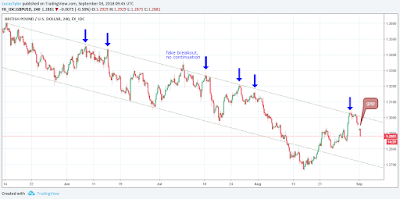Sterling to soar to 1.35 versus the greenback?
The British Pound is currently one of the most attractive currencies to buy, especially versus the US dollar and the Japanese yen. Several macroeconomic concerns used to hold Sterling from a rapid appreciation, however, they all seem to pass away shortly. First, the US presidential election is coming to a logical end, and the trick for GBP is that it can gain whoever will become the US President.
Donald Trump has always been an ardent supporter of the Brexit process as the British economy could have benefitted from integration to the US orbit while getting out of Brussel’s influence. The faster the Brexit sage will come to an end, the faster the British economy will start performing in the same way it did previously. High level of income and spending among the British population, infrastructure investments, and the role of London as one of the most important financial capitals of the world should direct the funds' inflow to the UK’s financial sector more affluent.
Joe Biden is also a good choice for Britons just because of his program to improve the international trade environment, get closer to China and EU, improve the global investment sentiment, and increase the risk appetite. Besides, the additional fiscal and monetary stimulus would create lucrative opportunities for carry-flow speculators interested in bargaining on yield difference. The outflow of US dollars should create additional demand for other major currencies, while the British Pound looks more attractive compared to other slow-moving majors.
When it comes to the technical analysis, the squeezed H4 chart above points to a huge ascending triangle with a horizontal baseline at 1.3500 dollars per pound. After the freefall in March 2020, caused by the coronavirus panic sell-off, the GBP/USD currency pair is in a continuous uptrend. The graphical analysis shows an obvious support trendline with three solid touchpoints (failed tests) as buy opportunities. The last one has been posted just recently, and Sterling’s bounce towards mid 1.28 figure was attractive to enter longs with a swing trading strategy. Those traders who used the opportunity of the market’s concern related to political and economical issues can enjoy quite a crispy haul now. Let’s have a look at whether it’s worth taking profits at this level, or should GBPUSD gain another couple of hundred points.
Bullish signs are as follows: the latest H4 candlestick has a close rate above the exponential moving average with a period of 144 bars; the Relative Strength Index charted a bounce-by-trend pattern at around the middle zone; the buying pressure is constant above the psychological figure of 1.3000 dollars per pound. The lack of bullish momentum can be explained by two factors. First, market players are expecting a final verdict for the presidential election and want to see the equity market reaction before pulling the trigger. Big money never rushes. Second, the US Federal Reserve and the Bank of England are going to have their meetings this week to announce the volume of further supportive measures, i.e. the amount of additional liquidity pumped into the financial sector.
This could cause a rapid rally of high-yield assets, and GBPUSD would not be an exclusion. Technically speaking, Sterling has to break through the 78.6% Fibonacci Retracement level at 1.3050. That will open the road towards the median resistance line slightly above 1.3200, and the triangle’s baseline at 1.3500 in extension. Patient traders with a deep buffer in the account balance can freely use a small portion of free margin to go long on Sterling. Remember though that GBPUSD is that kind of currency pair that can add surprising false whipsaws into the price action, so standing temporary under the water of 100-150 pips should not be a huge surprise but a chance to add more volume to longs.





